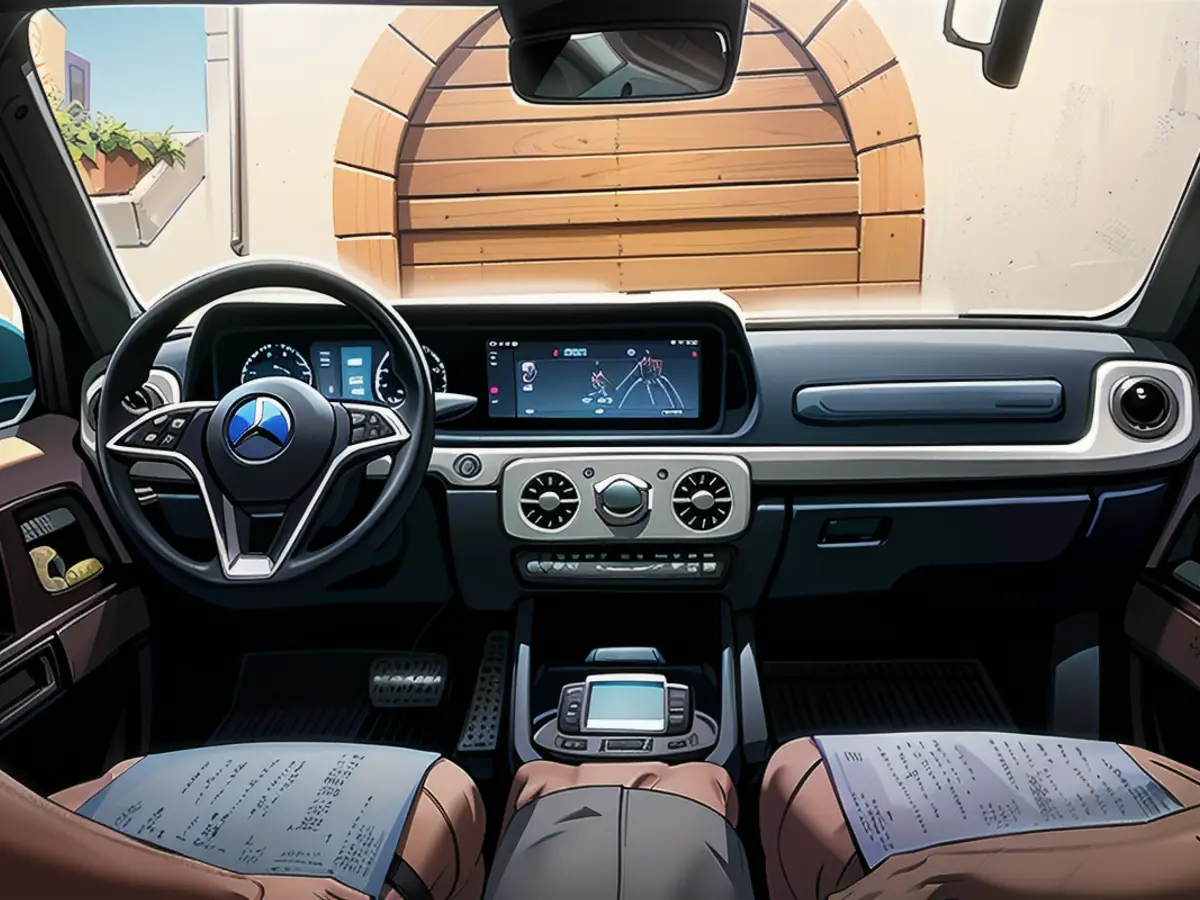The first drive of the latest Mercedes G-Class
Mercedes is refreshing its G-Class, and the changes go beyond cosmetic updates. New engines are being introduced, including an electric variant. ntv.de had the opportunity to drive all the versions.
To emphasize the tradition behind this brand, Mercedes brought along some classic G-Class models for the launch event. The first vehicle I took for a spin is a rare find: the twelve-cylinder G 65 AMG. Starting the six-liter engine brings a familiar hum, but it's a high-frequency scream rather than a rumble that's striking about this AMG version. I found myself more intrigued by the different engine noise than the power of the 630 horsepower. However, the handling of this G-Class isn't as stable; the vintage suspension system pushes powerfully, but there's a sense of instability when accelerating, making you fear for your safety on the road. Testing the limits of this car's speed is unimaginable due to the less stable steering.
The era of slower cars meant less difficulty for the early G230 and G280 models, with their 90 to 156 horsepower engines. Despite the unrefined cockpit, they're easier to drive than the classic vehicles before them, but you must be prepared for manual shifting. The most notable difference between the four and six-cylinder models is the improved refinement in the latter version. Not to be forgotten, the less powerful early models feature power steering, making the drive more comfortable.

Now, we turn to the newly presented model. The most noticeable difference between it and its predecessor is the battery-electric variant in the G-Class lineup. The first car we highlight is the G 500, with a 449 horsepower engine (boosted to 469 with the starter generator). The three-liter, twin-turbocharged engine replaces the V8, but it still delivers impressive performance. For those who can't stand the noise of the previous civilian V8 version, this one satisfies their needs. The G 500 is refined in its sound and performance; it now accelerates remarkably faster (5.4 seconds from 0 to 100 km/h) and achieves a top speed of 210 km/h. The comfort and precision of this new five-hundred model make it a viable choice as a daily driver, and the nine-speed automatic transmission appears in all versions.
For those who still yearn for the four-wheel-drive experience, Mercede's G 63 answers the call. With an eight-cylinder engine available for 189,329 euros (versus the G 500's 132,328 euros), you'll experience a near-identical power output to the previous model (585 hp). The only difference is that there are 20 extra electric horses powering the G 63 to conserve fuel. According to Mercedes, the fuel consumption of the G 63 will be roughly 14.7 - 15.7 liters for every 100 kilometers (WLTP), a notable increase compared to the G 500 (10.9 - 12.3 liters). However, given the target audience, this fact shouldn't overly concern them.

The G-Class evolution showcases an interesting balance between tradition and innovation, mixing vintage charm with modern advances. With these new engines, Mercedes is catering to a wider range of drivers, while the battery-electric variant helps meet the growing demand for eco-friendly vehicles.
The thrill of the Ride Control suspension, an adjustable pitch and roll feature, takes center stage. With the assistance of a pump, the system generates the required pressure, allowing for a more dynamic or comfortable ride based on the preferred program. The G 63 showcases its prowess on the test track, showcasing its rally car-like qualities. While performing admirably on smooth tarmac, this Sport-G achieves speeds of up to 240 km/h and maintains a decent level of comfort even during long drives.

The real game-changer, however, is the introduction of an electric drive to the G-Class. Although the fine-tuning improves the vehicle, it's the electric option that truly sets it apart. The battery-powered G-Class has notable advantages in its off-road capabilities, yet it's often overlooked by users. It's high time people realized the value of this feature.
The G 63's amazing on-road performance defies its weight and delivers a thrilling, efficient driving experience with 587 hp from four engines. However, its 116 kWh battery (net) only lasts for a maximum of 473 kilometers as per WLTP and takes 32 minutes to charge at 200 kW. While an imitation V8 sound can be simulated via an abundance of speakers, the actual experience can't be matched.

Electric Power Fuels Off-Road Domination
The standout feature of the G-Class is how flawlessly it handles off-road scenarios. Activating the throttle of the G 580 'with EQ technology' on a steep, rocky incline allows you to adjust the vehicle's progress precisely, which the combustion engine monitors. This allows you to control the torque and thus master the muddy, rough terrain. Its advanced transmission unit serves each wheel with a unique reduction ratio, ensuring exceptional off-road abilities. Coasting recuperation helps preserve the powerful energy expended by the electric engine.

The G 580, equipped with e-technology, excels at descending a 100% slope and traverses underwater through a water crossing. Its lower-than-conventional height (85 centimeters) prevents water from submerging the engine. With a nearly flat 35-degree lean, this SUV exudes a sense of stability and confidence. Going over stony ground while using off-road cruise control can invoke fear due to the powerful thumps and bumps, but the passenger seat's grinning occupant reassures you that the floor panel, a combination of carbon materials built in a three-centimeter thickness, prevents damage to the battery.
The electric G 580 is a true off-road champion. Although a decrease in vehicle mass leads to potential savings on company car tax, the absence of a trailer coupling may discourage some customers. Despite its failure to replicate the energy-induced G-Steer and G-Turn, the G-Class's performance impresses both spectators and drivers with its impressive off-road agility. The G 63, a similarly powerful variant, sprints faster at 4.7 seconds with a listed top speed of 180 km/h, but it trails behind in terms of price, listed at €142,621.

In conclusion, the battery-powered G-Class offers desirable off-road perks that may outweigh any potential drawbacks, ultimately making it an attractive option for certain consumers.
Check out these gallery to see it in action!

In conclusion, the most logical option would be the 3-liter inline six-cylinder diesel engine with a significant 750+200 Newton meters of torque, recently enhanced to 367+20 hp and electrified. This no-nonsense, growling (yet inconspicuously silent) diesel engine excels at hauling 3.5 tons with ease, just like the other combustion engines, while maintaining its efficient operations. When coupled with the nine-speed gearbox, it provides seamless and speedy acceleration (reaching 100 km/h in 5.8 seconds and reaching a top speed of 210 km/h). All these performances are delivered with grace and finesse, making the cost of 122,808 euros worth every penny.

The diesel variant benefits from three 100% differential locks, delivering supreme off-road capability while retaining the luxury and comfort of a premium car driving experience. Additionally, with its WLTP-certified fuel consumption rate of 8.7 liters per 100 kilometers, the W465 offers unprecedented fuel efficiency and practicality. It boasts an impressive range of over 1100 kilometers and ample cargo space of more than 2000 liters, cementing its position as an icon of modernity.
Read also:
The Mercedes G-Class also has a rich history of off-road capabilities, with earlier models like the G230 and G280 proving their worth on rugged terrains. These classic vehicles, despite their less powerful engines and primitive cockpits, were admired for their off-road prowess.
Mercedes' new lineup of Mercedes models includes an off-road variant that's making waves in the industry. The brand's electric vehicles, including the battery-electric G-Class, are pushing the boundaries of off-road dominance with their advanced capabilities and minimal impact on the environment.
Source: www.ntv.de








